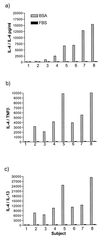Heterophile antibodies segregate in families and are associated with protection from type 1 diabetes
- PMID: 10393957
- PMCID: PMC22197
- DOI: 10.1073/pnas.96.14.8116
Heterophile antibodies segregate in families and are associated with protection from type 1 diabetes
Abstract
Markedly elevated levels of serum IL-4 were reported previously in 50% of a small group of type 1 diabetes nonprogessors. To determine the patterns of expression for this phenotype, a larger cohort of 58 families containing type 1 diabetic patients was examined. Analysis of the two-site ELISA assay used to measure serum IL-4 revealed evidence for heterophile antibodies, i.e., nonanalyte substances in serum capable of binding antibodies mutivalently and providing erroneous analyte (e.g., IL-4) quantification. Interestingly, relatives without type 1 diabetes were significantly more likely to have this phenotype than were patients with the disease (P = 0.003). In addition, the trait appears to have clustered within certain families and was associated with the protective MHC allele DQB1*0602 (P = 0.008). These results suggest that heterophile antibodies represent an in vivo trait associated with self-tolerance and nonprogression to diabetes.
Figures


Similar articles
-
Heterophile anti-mouse immunoglobulin antibodies may interfere with cytokine measurements in patients with HLA alleles protective for type 1A diabetes.Diabetes. 1999 Nov;48(11):2166-70. doi: 10.2337/diabetes.48.11.2166. Diabetes. 1999. PMID: 10535450
-
Both DQA1 and DQB1 genes are implicated in HLA-associated protection from type 1 (insulin-dependent) diabetes mellitus in a British Caucasian population.Diabetologia. 1993 Mar;36(3):252-7. doi: 10.1007/BF00399959. Diabetologia. 1993. PMID: 8462775
-
Susceptibility and resistance alleles of human leukocyte antigen (HLA) DQA1 and HLA DQB1 are shared in endocrine autoimmune disease.J Clin Endocrinol Metab. 1995 Jul;80(7):2112-7. doi: 10.1210/jcem.80.7.7608264. J Clin Endocrinol Metab. 1995. PMID: 7608264
-
Genetic susceptibility factors of Type 1 diabetes in Asians.Diabetes Metab Res Rev. 2001 Jan-Feb;17(1):2-11. doi: 10.1002/1520-7560(2000)9999:9999<::aid-dmrr164>3.0.co;2-m. Diabetes Metab Res Rev. 2001. PMID: 11241886 Review.
-
Genes influencing innate and acquired immunity in type 1 diabetes and latent autoimmune diabetes in adults.Ann N Y Acad Sci. 2006 Oct;1079:67-80. doi: 10.1196/annals.1375.010. Ann N Y Acad Sci. 2006. PMID: 17130534 Review.
Cited by
-
Pro- and anti-inflammatory cytokine production by autoimmune T cells against preproinsulin in HLA-DRB1*04, DQ8 Type 1 diabetes.Diabetologia. 2004 Mar;47(3):439-450. doi: 10.1007/s00125-003-1315-1. Epub 2004 Jan 24. Diabetologia. 2004. PMID: 14745491
-
Biochemical analysis of CTLA-4 immunoreactive material from human blood.BMC Immunol. 2009 Sep 22;10:51. doi: 10.1186/1471-2172-10-51. BMC Immunol. 2009. PMID: 19772653 Free PMC article.
-
Enhanced anti-serpin antibody activity inhibits autoimmune inflammation in type 1 diabetes.J Immunol. 2012 Jun 15;188(12):6319-27. doi: 10.4049/jimmunol.1200467. Epub 2012 May 16. J Immunol. 2012. PMID: 22593614 Free PMC article.
-
Adeno-associated virus vector-mediated IL-10 gene delivery prevents type 1 diabetes in NOD mice.Proc Natl Acad Sci U S A. 2001 Nov 20;98(24):13913-8. doi: 10.1073/pnas.251532298. Proc Natl Acad Sci U S A. 2001. PMID: 11717448 Free PMC article.
-
Anti-serpin antibody-mediated regulation of proteases in autoimmune diabetes.J Biol Chem. 2013 Jan 18;288(3):1612-9. doi: 10.1074/jbc.M112.409664. Epub 2012 Nov 29. J Biol Chem. 2013. PMID: 23195956 Free PMC article.
References
-
- Atkinson M A, Maclaren N K. N Engl J Med. 1994;331:1428–1436. - PubMed
-
- Roep B O. Diabetes. 1996;45:1147–1156. - PubMed
-
- Davies J L, Kawaguchi Y, Bennett S T, Copeman J B, Cordell H J, Pritchard L E, Reed P W, Gough S C L, Jenkins S C, Palmer S, et al. Nature (London) 1994;371:130–136. - PubMed
-
- Hashimoto L, Habita C, Berasi J P, Delepine M, Besse C, Cambon-Tomsen A, Deschamps L, Rotter J L, Djoulah S, James M R, et al. Nature (London) 1994;371:161–164. - PubMed
Publication types
MeSH terms
Substances
Grants and funding
LinkOut - more resources
Full Text Sources
Medical
Research Materials

